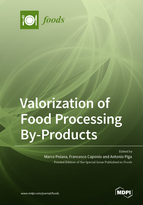Valorization of Food Processing By-Products
A special issue of Foods (ISSN 2304-8158). This special issue belongs to the section "Food Security and Sustainability".
Deadline for manuscript submissions: closed (15 July 2022) | Viewed by 59374
Special Issue Editors
Interests: olive oil; table olive; antioxidants; extraction
Interests: olive oil; food by-products; bioactive compounds; polyphenols
Special Issues, Collections and Topics in MDPI journals
Interests: olive oil; table olives; food by-products; polyphenols
Special Issues, Collections and Topics in MDPI journals
Special Issue Information
Dear Colleagues,
Nowadays the zero waste is an important goal for all the manufacturing activities. Food processing produce by-products that could contain an important amount of value when they become an output. In a circular economy, it is very important to aim at a complete recovery of molecules, energy and biomass from by-products that should not call waste but they should be named “secondary products”. For these reasons, the by-product treatments should be integrated into the whole chain of production and distribution of foodstuffs. By mean of controlled fermentations and appropriate treatments, we could be obtained biogas and compost for agricultural use from food processing by-products. Other researches are carried out to obtain useful applications from them. Surely, the most interesting is the extraction of active compounds or fractions that could be re-used in food processing or other fields such as cosmetic, pharmaceutical and bio-materials production. Many innovative operations could be applied to food by-products to obtain high quality value with a wide range of possible applications. In the near future, these aspects will greatly increase their importance, so a collection of high innovative manuscripts could be useful to the scientific community. This Special Issue is therefore open to all contributions aimed at improve knowledge about food processing by-products.
Prof. Dr. Marco Poiana
Prof. Dr. Francesco Caponio
Prof. Dr. Antonio Piga
Guest Editors
Manuscript Submission Information
Manuscripts should be submitted online at www.mdpi.com by registering and logging in to this website. Once you are registered, click here to go to the submission form. Manuscripts can be submitted until the deadline. All submissions that pass pre-check are peer-reviewed. Accepted papers will be published continuously in the journal (as soon as accepted) and will be listed together on the special issue website. Research articles, review articles as well as short communications are invited. For planned papers, a title and short abstract (about 100 words) can be sent to the Editorial Office for announcement on this website.
Submitted manuscripts should not have been published previously, nor be under consideration for publication elsewhere (except conference proceedings papers). All manuscripts are thoroughly refereed through a single-blind peer-review process. A guide for authors and other relevant information for submission of manuscripts is available on the Instructions for Authors page. Foods is an international peer-reviewed open access semimonthly journal published by MDPI.
Please visit the Instructions for Authors page before submitting a manuscript. The Article Processing Charge (APC) for publication in this open access journal is 2900 CHF (Swiss Francs). Submitted papers should be well formatted and use good English. Authors may use MDPI's English editing service prior to publication or during author revisions.
Keywords
- reuse
- recovery value
- active compounds
- extraction
- fermentation
- new ingredients
- new use
- no-waste








